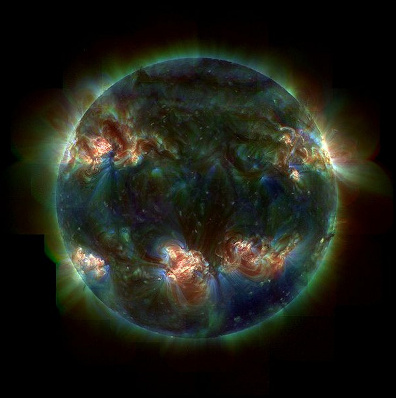| Tikalon Blog is now in archive mode.
An easily printed and saved version of this article, and a link
to a directory of all articles, can be found below: |
|
This article |
| Directory of all articles |
Stuck in the Solar Minimum
June 16, 2010
Most things in Nature are cyclic. We have night and day, caused by the rotation of the
Earth; and we have our seasons, caused by the inclination of our rotational axis with respect to our yearly orbit around the
Sun. The Sun has its own rotation around its axis, but since it's a ball of gas, its rotation rate differs from the equator to the pole. The Sun's equatorial rotation period is about 25 days, but its a little more than 34 days at its poles.
One other periodicity of the Sun is its eleven year
sunspot cycle. Sunspots are an indicator of solar magnetic activity, and they peak every eleven years. We are presently in a period of minimum solar activity. The magnetic fields involved inhibit convection of the hot gases, so the sunspot regions are cooler than their surroundings and appear darker. They may be darker, but the temperature of gas in sunspots is still about four thousand
Celsius degrees. The surrounding bright gas is about 5,700 Celsius degrees. The precise reason for this periodicity is unknown, although one clue is that sunspots in a waxing cycle appear at solar mid-latitudes, and those in a waning solar cycle appear near the solar equator.

Sun in the Ultraviolet.
One unusual feature of our present solar minimum is its length. In a
previous article (Solar Cycle 24, July 31, 2008), I wrote that January 4, 2008, was determined to be the start of our newest solar cycle, called Solar Cycle 24. We are now more than two years into this cycle, and the Sun's been exceptionally quiet. Various theories are floating around, but astrophysicists aren't quite sure what's happening. Frank Hill of the
National Solar Observatory, made this remark at the recent semiannual meeting of the
American Astronomical Society (May 23-27, 2010, Miami, Florida) [1]
...I'm gratified to see that we all agree that this is an interesting minimum... What's not so gratifying is we have no clue why any of these effects are happening.
This quiet minimum is not unusual. Sunspots were nearly absent in the period 1645-1715, the so-called
Maunder Minimum. Only fifty sunspots appeared
in toto for the period, as compared to the tens of thousands typically observed in a similar interval, and no sun spots were observed at all during 1670. [2-3] What's especially interesting is that the Maunder Minimum coincides with the
Little Ice Age, a period of extremely cold winters. How the Sun's state and Earth climate are connected is not known. That's why science is important. There are web sites that allow you to monitor the present solar cycle for yourself [4-5].
NASA has posted some dire predictions about what might happen once the current solar cycle ramps into activity [6,7]. NASA is predicting that there will be unprecedented solar flare activity that will cause major magnetic disturbances on Earth. These magnetic storms have affected power transmission networks in the past, since the transmission lines act as huge inductors that transform the magnetic flux to electrical current. Our increased dependence on electronic gadgets will be a problem, since communications satellites and GPS receivers could be affected. Since I'm a magnetics expert, I can assure you that neither the magnetic disks in your computer hard drives or the magnetic stripes on your credit cards will be harmed. The
coercivity of the magnetic materials used in these is too high. However, the
electronics in your hard drive and in ATM machines are another matter, so I can't pass judgment on those.
Sunshine (2007, Danny Boyle, Director) is a nonsensical, but entertaining film set in 2057 about a mission to restart a dying sun with a huge nuclear weapon [8].
References:
- John Matson, "Solar Scientists Agree That the Sun's Recent Behavior Is Odd, but the Explanation Remains Elusive," Scientific American Online (May 27, 2010).
- Maunder Minimum on Wikipedia.
- List of solar cycles on Wikipedia.
- Solar Cycle 24 Prediction Web Site (NOAA Space Weather Prediction Center)
- Homepage of the Solar Influences Data Analysis Center (Royal Observatory of Belgium)
- Andrew Hough, "Nasa warns solar flares from 'huge space storm' will cause devastation," Telegraph UK Online (June 14, 2010).
- As the Sun Awakens, NASA Keeps a Wary Eye on Space Weather (NASA, June 4, 2010).
- Sunshine (2007) on Wikipedia.
Permanent Link to this article